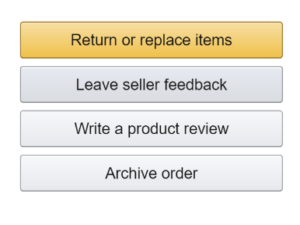
How To Use Amazon Drip Emails To Receive Feedback
You may be asking, “What is an email drip campaign?” or “How can this help my business on Amazon?” Well, an email drip campaign is a marketing strategy that “drips” relevant emails to customers for a period of time to improve the overall customer experience. In Amazon, it’s a crucial technique to increase positive reviews and prevent negative ones.
Before we can discuss Amazon marketing and email drip campaign best practices, you first need to establish if you want Product Reviews or Seller Feedback. Perhaps you want to focus on product reviews to improve click-through and conversion rate, or you may want to improve your seller feedback to win the buy box more often. Feedback Genius or any email drip marketing strategy on Amazon can help your business automate your Email Drip campaigns to automatically send product emails.
Keep reading for best practices for improving reviews, some overarching dos and don’ts, and which practices not allowed by Amazon.
Prevent Negative Reviews
With email drip campaigns, you can reach out to customers at different times throughout their purchase cycle. The best practice to prevent negative reviews is to send an email to the customer when the item has shipped (or 1-2 days after shipment). In this message, we want the customer to understand they can contact you directly through the Amazon Messaging system for any complaints or questions creating a dialogue so they feel comfortable reading/responding to your emails. Include above and beyond-type details that will increase the customer’s user experience, like washing instructions or ideas for how to use the product. This could take the form of a video, image, or PDF attachment. And important to note: always make sure to follow Amazon’s Terms of Service (more on that later).
Here is an example of a purchase confirmation email:
Hello [first name],
First of all, thank you for purchasing [product name]
Our records show your order has shipped and will arrive by [estimated arrival].
We included our favorite decoration hacks to make your room awesome. Hope these can help you decorate your space!

If you have any questions at all, please [contact link: send us a message] so we can help you out!
Thanks again!
Customer Service Team
Get Seller Feedback
Seller feedback is defined as reviews customers leave on the quality of your service and overall experience with you as the seller. This rating shows up on your seller page and next to your name when you compete for the buy box. Your Seller Rating is important in many ways to help win the buy box. If you are looking to increase seller feedback, it is recommended that you send an email one to two days after delivery.

Get Product Reviews
Product reviews are key to improving your listing’s conversion rate and click-through rate, which will increase your purchase likelihood and overall organic ranking. Best practice is to send an email once the customer has time to use and test out the product, which is on average five to seven days after delivery.
Here is an example of a follow-up email that can lead to a review:
Hello [first name],
Thank you again for purchasing [product name]!
Our customer support doesn’t end with your purchase. If there are any issues with your order, please [contact link: send us a message] by responding to this email so we can help you out.
Your opinion matters, and other shoppers would love to hear what you have to say. If you haven’t already left a review, it would be awesome if you could share your thoughts!
[product review link: Write your review here]
Thank you,
Customer Service Team
Basic Best Practices
-
- Automate messages asking for a product review when someone leaves 5-star seller feedback. Subject Line is KING! The subject line should be tailored to the product and entice the customer to open the email.
- Use a blacklist, which ignores customers on future emails if they’ve left negative feedback.
- In your first email, provide information that will solve one to three pain points for your product. This will help the customer with issues that may arise, but also increase their likelihood of opening your following emails for a review.
- Keep your email schedule consistent for all products, but tailor different emails to specific ASINs. This will allow you to tailor your content specifically toward that product and prevent double sending emails day after day.
-
-
- Filter in each email which ASINs you want to be targeted
-
Practices Not Allowed by Amazon
-
- Links to any website
- Seller logos if they contain or display a link to the seller’s website
- Any marketing message or promotion
- Any promotions for additional products or referrals to third-party products or promotions




